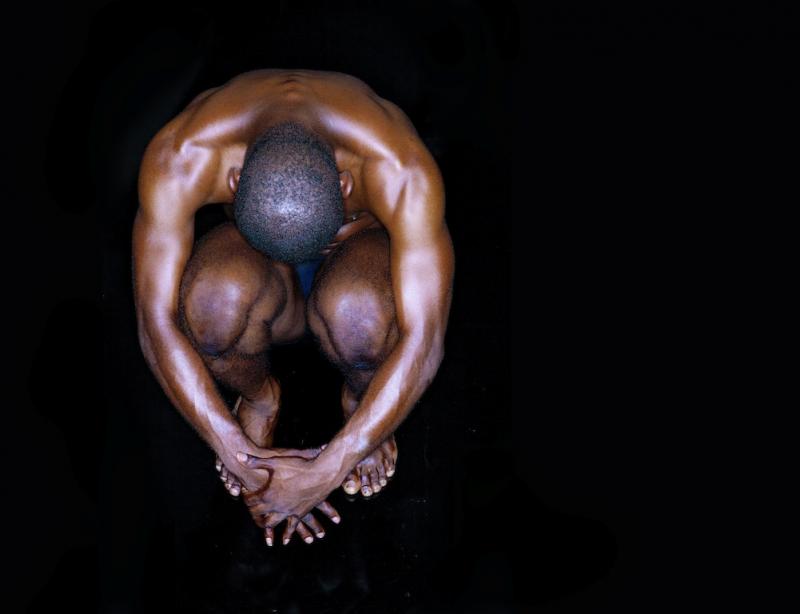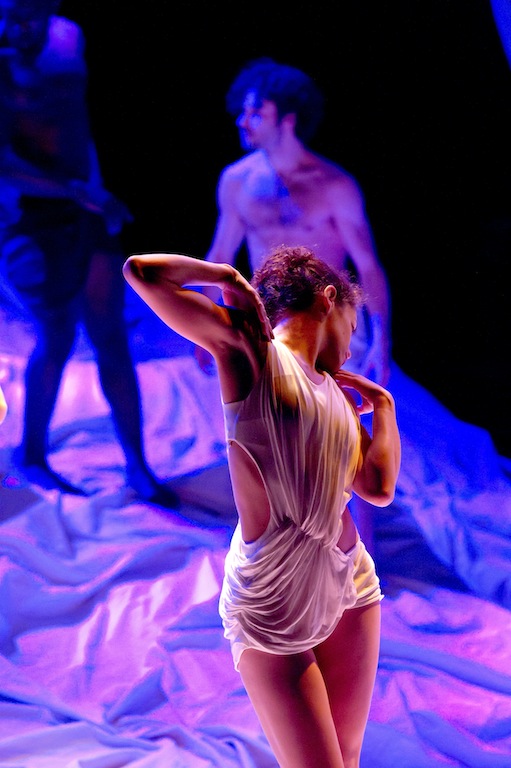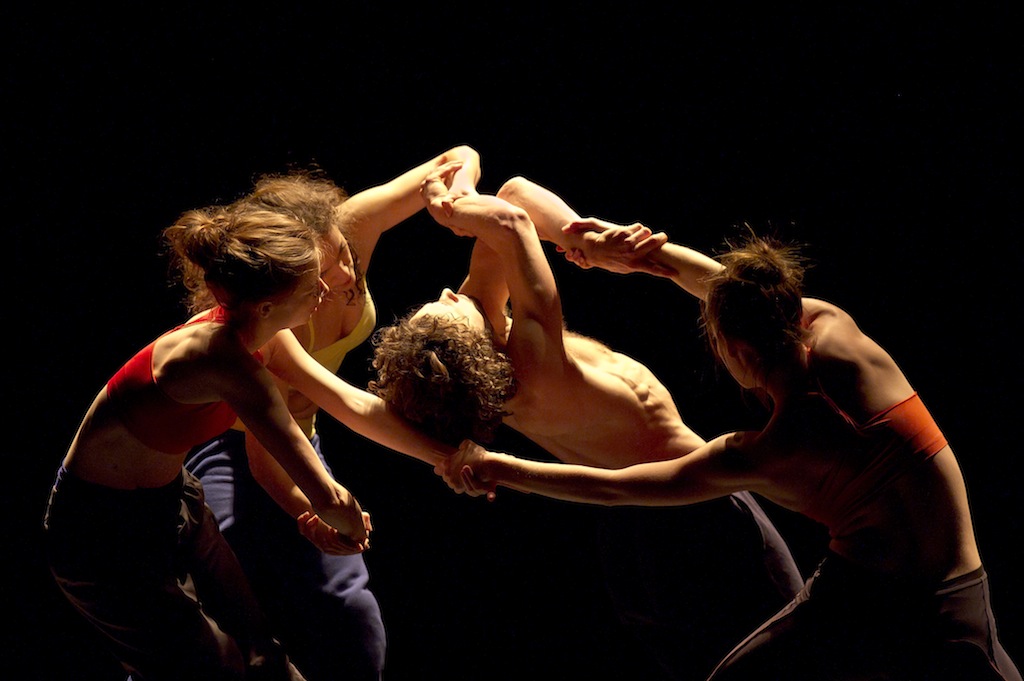Russell Maliphant, The Rodin Project, Sadler’s Wells | reviews, news & interviews
Russell Maliphant, The Rodin Project, Sadler’s Wells
Russell Maliphant, The Rodin Project, Sadler’s Wells
Street culture and high art merge as the past fuses with the present

Imagine that Rodin’s Thinker gets bored with sitting, head-on-hand, contemplating the folly of humankind and, springing to life, descends from his lofty perch above The Gates of Hell. Having been immobile for a century or more, he is extremely stiff and needs to limber up: cue for some first-rate body popping interspersed with the kind of heroic poses usually reserved for life drawing classes.
This surreal scenario provides a glimpse of the contrasting ideas and impulses informing Russell Maliphant’s latest work. In The Rodin Project, images from the sculptor’s drawings and bronzes are given life in real time, rather than the limbo of the endless present where art normally resides. As a result, the 19th and 21st centuries are made to collide sometimes awkwardly, and sometimes with real magic.
Rodin often drew and sculpted figures in motion; we are used to artists trying to capture movement in still images, but it seems perverse to invert the process by animating static objects. One involves distilling a movement to its essence by creating a moment of balance; the other requires amplification – inventing what comes after stillness and introducing imbalance. And Maliphant doesn’t always pull it off.
 Slowed to a dream-like tempo, the first half takes place on and around a white mound that looks like a tableau rigged up with bedsheets to approximate rocks or an ice flow (pictured right). We seem to be in a 19th-century studio belonging to an artist like Delacroix, Géricault or Lord Leighton with a penchant for theatrics and classical Greek art, rather than Rodin, whose thinking was far more modern. Dressed in loincloths and toga-like drapes, the three female dancers resemble nymphs from ancient Greek friezes, while the men are dead ringers for Dying Slaves or Fallen Warriors. Although they move fluently from one pose to another, they seem as joyless as an artist’s model required to hold an endless series of difficult poses. Slow delivery even robs the capoeira bout of all passion which, given the obvious expertise of Tommy Franzén and Thomasin Gülgec, is extremely frustrating.
Slowed to a dream-like tempo, the first half takes place on and around a white mound that looks like a tableau rigged up with bedsheets to approximate rocks or an ice flow (pictured right). We seem to be in a 19th-century studio belonging to an artist like Delacroix, Géricault or Lord Leighton with a penchant for theatrics and classical Greek art, rather than Rodin, whose thinking was far more modern. Dressed in loincloths and toga-like drapes, the three female dancers resemble nymphs from ancient Greek friezes, while the men are dead ringers for Dying Slaves or Fallen Warriors. Although they move fluently from one pose to another, they seem as joyless as an artist’s model required to hold an endless series of difficult poses. Slow delivery even robs the capoeira bout of all passion which, given the obvious expertise of Tommy Franzén and Thomasin Gülgec, is extremely frustrating.
In the second half, the white sheets are replaced by black slopes resembling a skateboard park. Dressed like kids in leggings and tank tops, the dancers (pictured below) slide, roll, jump and somersault. The moments of stillness now seem like a BMXer pausing at the top of a slope rather than an artist’s model holding a pose – until, that is, a dancer takes off her togs and, apparently naked, assumes the roles of Rodin’s Iris, Medea, Nymph and Muse. The Burghers of Calais put in a brief but unfortunate appearance; soon, though, its the turn of Dickson Mbi who has enormous dignity and presence as well as a superb physique, so rather than imitating a Rodin bronze, he seems miraculously to become one. His body suddenly jerks into break dancing robotics, then returns to stasis as he flips between past and present and between gravity and apparent weightlessness.
 Past and present fuse in even more miraculous union, when Mbi and Franzén perform a duet on top of and up the side of a wall. Climbing up and balancing against the vertical surface like urban free runners, they also become the damned writhing in anguish on Rodin’s The Gates of Hell. Never have street culture and high art been so effortlessly joined, or past and present been brought together so seemlessly. Its a long moment of pure poetry that is as fresh and as original as Rodin’s Iris must have seemed in 1900. You don’t have to be familiar with Rodin’s work to appreciate the brilliance of this fusion, but it helps so look up The Gates of Hell before you go.
Past and present fuse in even more miraculous union, when Mbi and Franzén perform a duet on top of and up the side of a wall. Climbing up and balancing against the vertical surface like urban free runners, they also become the damned writhing in anguish on Rodin’s The Gates of Hell. Never have street culture and high art been so effortlessly joined, or past and present been brought together so seemlessly. Its a long moment of pure poetry that is as fresh and as original as Rodin’s Iris must have seemed in 1900. You don’t have to be familiar with Rodin’s work to appreciate the brilliance of this fusion, but it helps so look up The Gates of Hell before you go.
Explore topics
Share this article
The future of Arts Journalism
You can stop theartsdesk.com closing!
We urgently need financing to survive. Our fundraising drive has thus far raised £49,000 but we need to reach £100,000 or we will be forced to close. Please contribute here: https://gofund.me/c3f6033d
And if you can forward this information to anyone who might assist, we’d be grateful.

Subscribe to theartsdesk.com
Thank you for continuing to read our work on theartsdesk.com. For unlimited access to every article in its entirety, including our archive of more than 15,000 pieces, we're asking for £5 per month or £40 per year. We feel it's a very good deal, and hope you do too.
To take a subscription now simply click here.
And if you're looking for that extra gift for a friend or family member, why not treat them to a theartsdesk.com gift subscription?
more Dance
 'We are bowled over!' Thank you for your messages of love and support
Much-appreciated words of commendation from readers and the cultural community
'We are bowled over!' Thank you for your messages of love and support
Much-appreciated words of commendation from readers and the cultural community
 R:Evolution, English National Ballet, Sadler's Wells review - a vibrant survey of ballet in four acts
ENB set the bar high with this mixed bill, but they meet its challenges thrillingly
R:Evolution, English National Ballet, Sadler's Wells review - a vibrant survey of ballet in four acts
ENB set the bar high with this mixed bill, but they meet its challenges thrillingly
 Like Water for Chocolate, Royal Ballet review - splendid dancing and sets, but there's too much plot
Christopher Wheeldon's version looks great but is too muddling to connect with fully
Like Water for Chocolate, Royal Ballet review - splendid dancing and sets, but there's too much plot
Christopher Wheeldon's version looks great but is too muddling to connect with fully
 iD-Reloaded, Cirque Éloize, Marlowe Theatre, Canterbury review - attitude, energy and invention
A riotous blend of urban dance music, hip hop and contemporary circus
iD-Reloaded, Cirque Éloize, Marlowe Theatre, Canterbury review - attitude, energy and invention
A riotous blend of urban dance music, hip hop and contemporary circus
 How to be a Dancer in 72,000 Easy Lessons, Teaċ Daṁsa review - a riveting account of a life in dance
Michael Keegan-Dolan's unique hybrid of physical theatre and comic monologue
How to be a Dancer in 72,000 Easy Lessons, Teaċ Daṁsa review - a riveting account of a life in dance
Michael Keegan-Dolan's unique hybrid of physical theatre and comic monologue
 A Single Man, Linbury Theatre review - an anatomy of melancholy, with breaks in the clouds
Ed Watson and Jonathan Goddard are extraordinary in Jonathan Watkins' dance theatre adaptation of Isherwood's novel
A Single Man, Linbury Theatre review - an anatomy of melancholy, with breaks in the clouds
Ed Watson and Jonathan Goddard are extraordinary in Jonathan Watkins' dance theatre adaptation of Isherwood's novel
 Peaky Blinders: The Redemption of Thomas Shelby, Rambert, Sadler's Wells review - exciting dancing, if you can see it
Six TV series reduced to 100 minutes' dance time doesn't quite compute
Peaky Blinders: The Redemption of Thomas Shelby, Rambert, Sadler's Wells review - exciting dancing, if you can see it
Six TV series reduced to 100 minutes' dance time doesn't quite compute
 Giselle, National Ballet of Japan review - return of a classic, refreshed and impeccably danced
First visit by Miyako Yoshida's company leaves you wanting more
Giselle, National Ballet of Japan review - return of a classic, refreshed and impeccably danced
First visit by Miyako Yoshida's company leaves you wanting more
 Quadrophenia, Sadler's Wells review - missed opportunity to give new stage life to a Who classic
The brilliant cast need a tighter score and a stronger narrative
Quadrophenia, Sadler's Wells review - missed opportunity to give new stage life to a Who classic
The brilliant cast need a tighter score and a stronger narrative
 The Midnight Bell, Sadler's Wells review - a first reprise for one of Matthew Bourne's most compelling shows to date
The after-hours lives of the sad and lonely are drawn with compassion, originality and skill
The Midnight Bell, Sadler's Wells review - a first reprise for one of Matthew Bourne's most compelling shows to date
The after-hours lives of the sad and lonely are drawn with compassion, originality and skill
 Ballet to Broadway: Wheeldon Works, Royal Ballet review - the impressive range and reach of Christopher Wheeldon's craft
The title says it: as dancemaker, as creative magnet, the man clearly works his socks off
Ballet to Broadway: Wheeldon Works, Royal Ballet review - the impressive range and reach of Christopher Wheeldon's craft
The title says it: as dancemaker, as creative magnet, the man clearly works his socks off
 The Forsythe Programme, English National Ballet review - brains, beauty and bravura
Once again the veteran choreographer and maverick William Forsythe raises ENB's game
The Forsythe Programme, English National Ballet review - brains, beauty and bravura
Once again the veteran choreographer and maverick William Forsythe raises ENB's game

Add comment